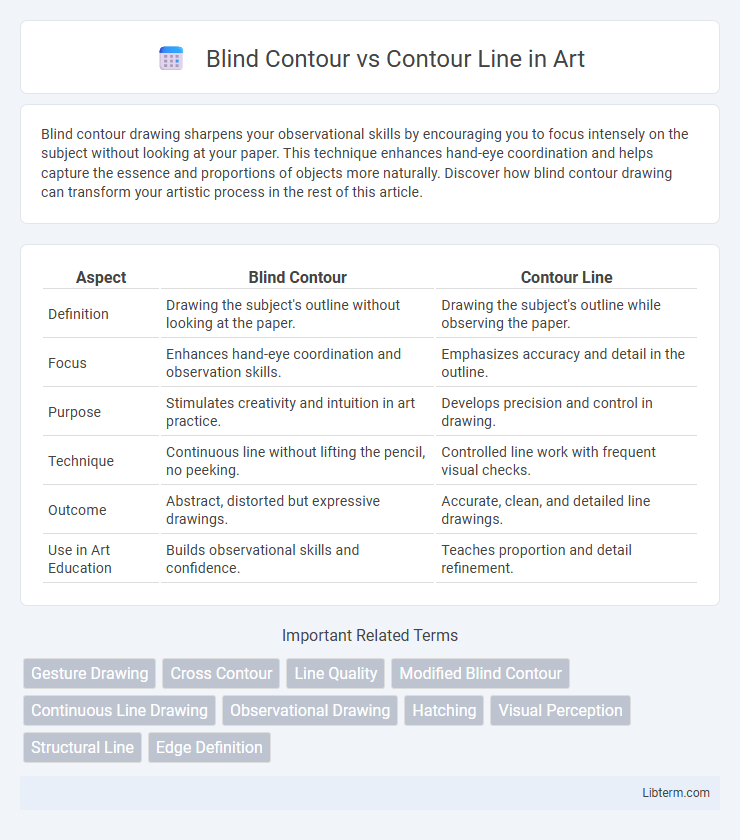Blind contour drawing sharpens your observational skills by encouraging you to focus intensely on the subject without looking at your paper. This technique enhances hand-eye coordination and helps capture the essence and proportions of objects more naturally. Discover how blind contour drawing can transform your artistic process in the rest of this article.
Table of Comparison
| Aspect | Blind Contour | Contour Line |
|---|---|---|
| Definition | Drawing the subject's outline without looking at the paper. | Drawing the subject's outline while observing the paper. |
| Focus | Enhances hand-eye coordination and observation skills. | Emphasizes accuracy and detail in the outline. |
| Purpose | Stimulates creativity and intuition in art practice. | Develops precision and control in drawing. |
| Technique | Continuous line without lifting the pencil, no peeking. | Controlled line work with frequent visual checks. |
| Outcome | Abstract, distorted but expressive drawings. | Accurate, clean, and detailed line drawings. |
| Use in Art Education | Builds observational skills and confidence. | Teaches proportion and detail refinement. |
Introduction to Blind Contour and Contour Line Drawing
Blind contour drawing involves sketching the subject's outline without looking at the paper, enhancing hand-eye coordination and observational skills. Contour line drawing requires closely observing the subject to carefully render detailed edges and surface ridges, emphasizing accuracy and form. Both techniques develop different aspects of visual perception and drawing precision essential for artists.
Defining Contour Line: What Is It?
A contour line represents the visible edges and boundaries of an object, capturing its precise shape and form through continuous lines that define volume and surface detail. Unlike blind contour drawing, which is done without looking at the paper to enhance observation skills, contour line drawing requires careful visual tracking to accurately depict the object's outlines. This technique is fundamental in art and design for developing hand-eye coordination and understanding three-dimensional structure on a two-dimensional plane.
Understanding Blind Contour Drawing Technique
Blind contour drawing emphasizes observing the subject closely while drawing without looking at the paper, enhancing hand-eye coordination and capturing the essence of shapes and details. Unlike traditional contour line drawing, where the artist visually monitors and refines the lines, blind contour requires continuous, uninterrupted line work that reflects a direct connection between observation and mark-making. This technique develops observational skills and train artists to perceive subtle contours, spatial relationships, and textures more accurately.
Key Differences: Blind Contour vs Contour Line
Blind contour drawing involves sketching the subject's outline without looking at the paper, emphasizing hand-eye coordination and capturing the essence of shapes. Contour line drawing, however, allows continuous observation of both the subject and the drawing, resulting in more accurate and detailed representations. The key difference lies in the level of visual feedback: blind contour restricts sight of the paper to enhance perception skills, while contour line drawing integrates direct observation for precision.
Artistic Benefits of Blind Contour Drawing
Blind contour drawing enhances observational skills by forcing artists to focus intensely on the subject's details without relying on visual feedback, resulting in more accurate and expressive representations. This technique encourages hand-eye coordination, improves line quality, and fosters spontaneous creativity, making drawings appear more dynamic and emotionally engaging. Artists often use blind contour as a warm-up exercise to break free from perfectionism and develop confidence in their mark-making abilities.
Visual Accuracy: Contour Line Drawing Advantages
Contour line drawing offers superior visual accuracy by precisely capturing the edges and details of the subject, enabling a clear and structured representation. This technique emphasizes the object's true form and spatial relationships, resulting in drawings that are more realistic and easily recognizable. Artists benefit from contour line drawing when accuracy and detail are essential for conveying texture, depth, and proportion.
When to Use Blind Contour in Art Practice
Blind contour drawing is ideal for enhancing observational skills and hand-eye coordination by forcing artists to focus intently on the subject without looking at the paper. This technique is particularly useful during warm-up exercises or when aiming to capture the essence and movement of a subject rather than precise details. Artists often use blind contour drawings early in their practice sessions to improve focus and reduce reliance on visual corrections, building a more intuitive connection between sight and mark-making.
Combining Both Techniques for Skill Development
Combining blind contour and contour line drawing techniques enhances observational accuracy and hand-eye coordination by engaging both immediate perception and controlled line placement. Blind contour encourages artists to capture the essence of form through continuous, unedited lines without looking, boosting sensory awareness and confidence. Integrating contour line drawing refines shape definition and structural understanding, creating a balanced approach that develops both intuition and technical precision in drawing skills.
Common Challenges and How to Overcome Them
Blind contour and contour line drawing both challenge artists to capture form and proportion without relying on visual shortcuts, often leading to distorted or inaccurate representations. Common problems include misjudging spatial relationships and losing track of the drawing surface, which can be mitigated by slowing down, maintaining consistent eye-to-subject focus, and practicing regularly to improve hand-eye coordination. Using tactile feedback and breaking down complex shapes into simpler contours also helps artists refine accuracy in both techniques.
Conclusion: Choosing the Right Technique
Choosing the right technique between Blind Contour and Contour Line depends on artistic goals and skill development needs. Blind Contour enhances observational skills and hand-eye coordination by forcing artists to focus solely on shape without visual feedback, while Contour Line offers precision and clarity with continuous visual monitoring. Incorporating both methods can yield a balanced approach, improving accuracy and expressive drawing capabilities.
Blind Contour Infographic

 libterm.com
libterm.com